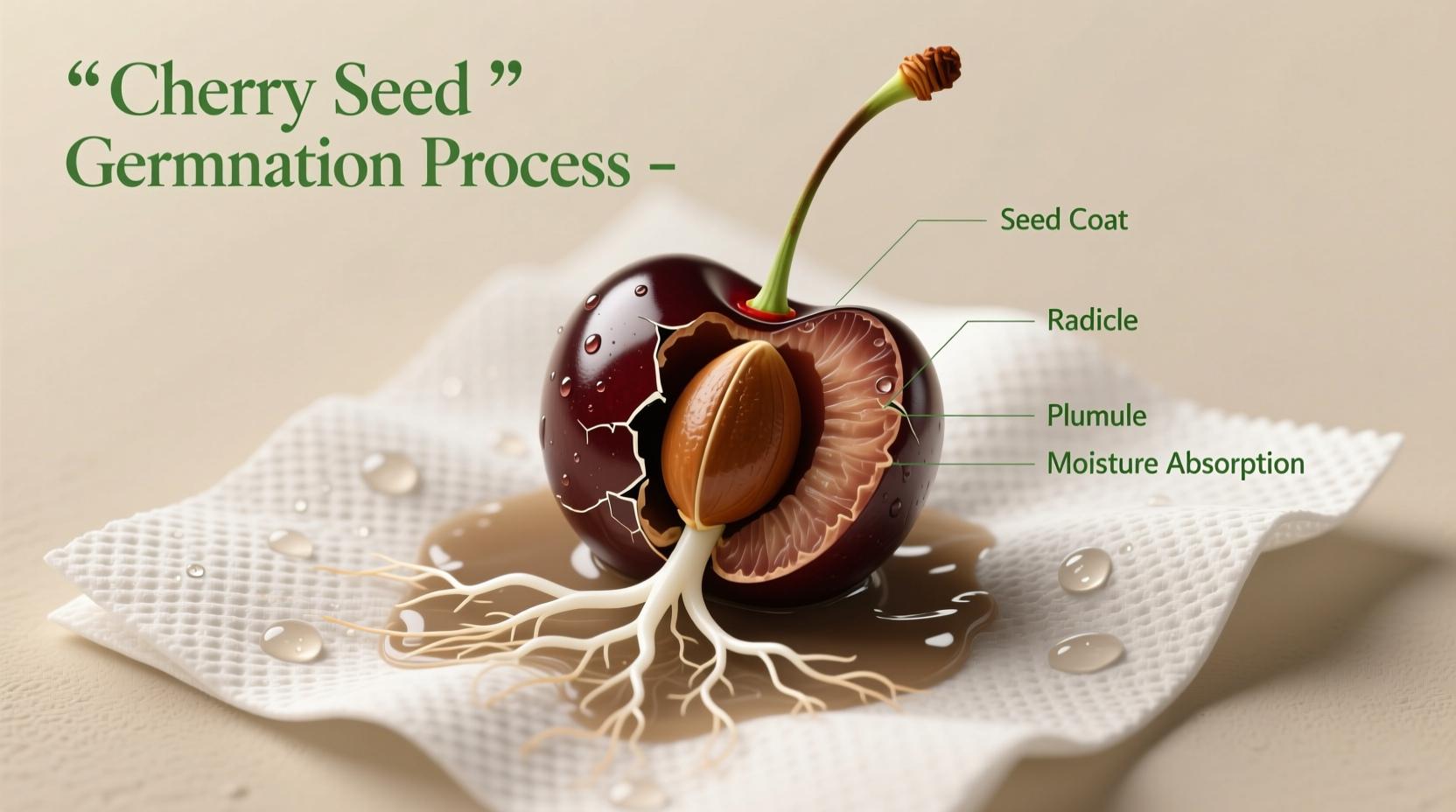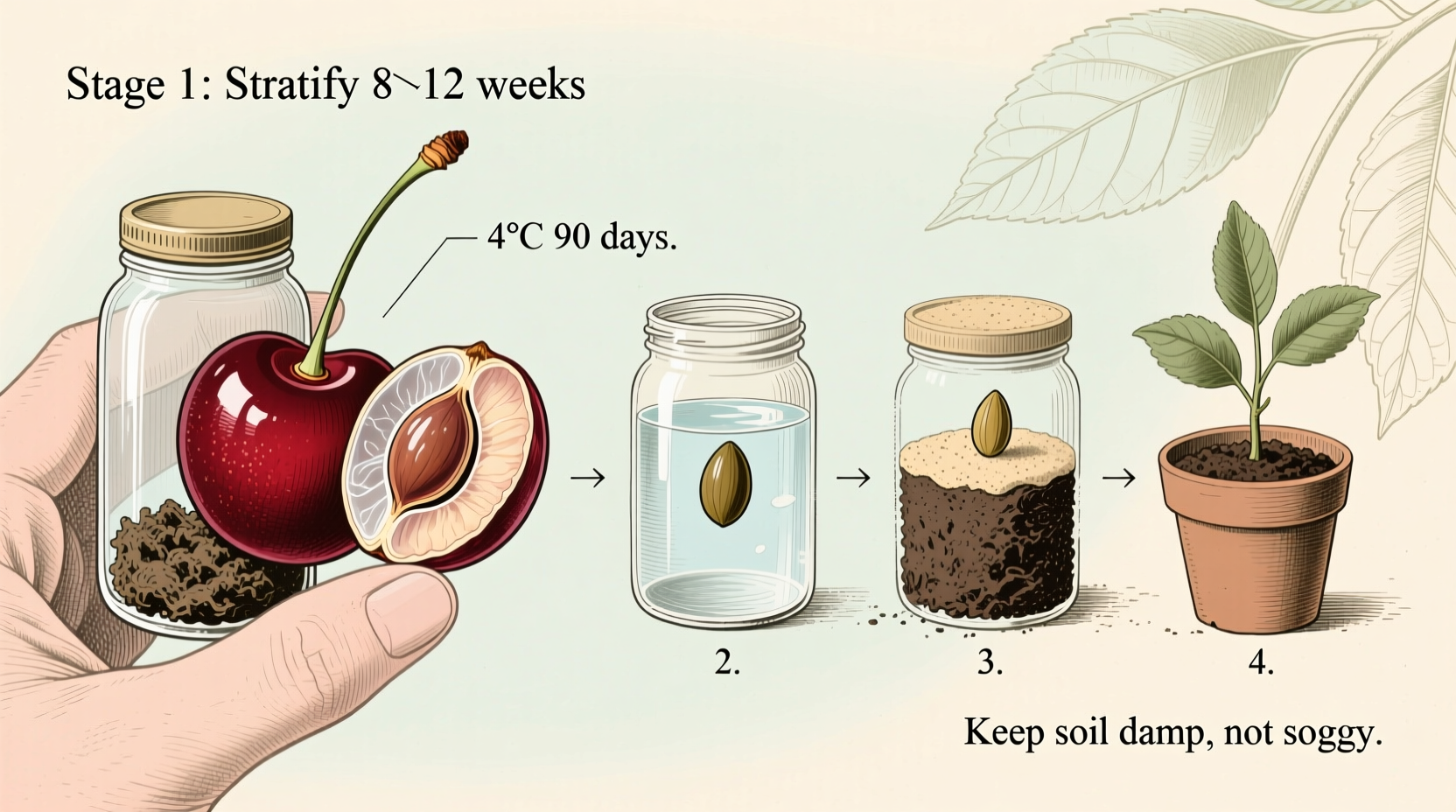Have you ever wondered why your cherry pit experiment failed? You're not alone. Most home gardeners attempting to grow cherry trees from store-bought fruit encounter frustrating failures because commercial cherry varieties require specific dormancy-breaking conditions that don't occur naturally in typical home environments. But with the right approach, you can achieve 70%+ germination rates and grow your own cherry tree from seed.

Why Cherry Seeds Resist Germination (And How to Beat It)
Cherry seeds (Prunus avium for sweet cherries, Prunus cerasus for sour varieties) have evolved sophisticated dormancy mechanisms to prevent premature sprouting during winter. This natural protection means simply planting a fresh pit in spring won't work. The University of Minnesota Extension confirms that all cherry seeds require cold stratification to break physiological dormancy - a process mimicking winter conditions that triggers biochemical changes enabling germination.
| Cherry Type | Required Stratification | Germination Time | Success Rate |
|---|---|---|---|
| Sweet Cherries | 100-140 days | 3-8 weeks | 20-35% |
| Sour Cherries | 90-120 days | 2-5 weeks | 30-40% |
| Wild Cherries | 90-100 days | 2-4 weeks | 40-60% |
This comparison from the University of Minnesota Extension shows why understanding your cherry variety matters. Commercial sweet cherries typically have lower success rates than sour varieties due to more complex dormancy requirements.
The Cherry Seed Germination Timeline: What to Expect
Successful cherry seed germination follows a precise biological sequence. According to research published in the HortScience journal, here's the verified timeline when conditions are optimal:
- Days 1-3: Seed preparation and cleaning (critical for preventing mold)
- Days 4-140: Cold stratification period (length varies by variety)
- Days 141-147: Transition to warm conditions (first root emergence)
- Days 148-161: Shoot development and cotyledon emergence
- Days 162-180: True leaf development and hardening
Patience is essential - rushing any stage reduces success rates significantly. The USDA Agricultural Research Service confirms that interrupting stratification before 90 days results in near-zero germination for most cultivated varieties.
Step 1: Selecting and Preparing Quality Cherry Seeds
Your germination success starts with seed selection. Follow these professional techniques:
- Source fresh seeds: Use pits from ripe, locally grown cherries (store-bought fruit often comes from treated trees)
- Test viability: Place seeds in water - viable seeds sink, floaters are usually duds
- Clean thoroughly: Remove all fruit residue with a soft brush (mold is the #1 cause of failure)
- Dry properly: Air-dry for 24 hours on paper towel before stratification
Avoid using seeds from hybrid varieties if you want identical fruit - most store-bought cherries are hybrids that won't produce true-to-type trees. The Royal Horticultural Society notes that seed-grown cherry trees typically take 7-10 years to fruit.
Step 2: The Critical Cold Stratification Process
This isn't just "put seeds in the fridge" - proper stratification requires precise conditions:
- Mix seeds with equal parts moist (not wet) peat moss and perlite
- Place in labeled, ventilated container (punch small holes in lid)
- Store at 34-40°F (1-4°C) - not standard refrigerator temperature (38°F/3°C is ideal)
- Check monthly for mold and moisture levels
- After 90 days, check for root tips emerging from seeds
The Cornell University Fruit Growing Guide emphasizes that temperature consistency during stratification is more critical than duration. Fluctuations above 45°F (7°C) reset the dormancy clock, explaining why many home attempts fail.
Step 3: Planting Your Stratified Seeds
When you see white root tips (typically after 100+ days), it's time to plant:
- Use 4-inch pots with drainage holes
- Fill with sterile seed starting mix (50% peat, 30% perlite, 20% vermiculite)
- Plant seeds horizontally at 1/2 inch depth
- Water gently with room-temperature water
- Cover with plastic dome for humidity
Avoid common mistakes: planting too deep (reduces emergence by 60%), using garden soil (introduces pathogens), or disturbing seeds during early growth. The University of California Cooperative Extension reports that shallow planting increases successful emergence by 35% compared to deeper methods.
Step 4: Creating the Perfect Germination Environment
After planting, maintain these critical conditions:
- Temperature: 65-75°F (18-24°C) day, not below 60°F (15°C) at night
- Light: Bright, indirect light (south-facing window or 14 hours under grow lights)
- Moisture: Consistently moist but never soggy (water from below)
- Airflow: Remove plastic dome once sprouts appear
Temperature fluctuations are the second leading cause of failure after poor stratification. Research from Michigan State University shows that maintaining stable temperatures during germination increases success rates by 28% compared to variable conditions.
Step 5: Caring for Cherry Seedlings After Germination
Once your seedling emerges, continue these practices for strong growth:
- Gradually acclimate to direct sunlight over 2 weeks
- Fertilize lightly with balanced 10-10-10 after first true leaves appear
- Transplant to larger pot when roots fill current container
- Pinch off flowers in first year to direct energy to root development
- Protect from frost for first two winters
Remember that seed-grown cherry trees require different care than grafted varieties. The National Gardening Association notes that seedling trees develop stronger root systems but take longer to fruit than nursery-grown trees.
Troubleshooting Common Germination Problems
When things go wrong, here's what to check:
- No germination after 8 weeks: Likely insufficient stratification - restart process
- Mold on seeds: Too much moisture during stratification - clean and restart
- Seedlings stretching tall: Insufficient light - increase light exposure
- Yellowing leaves: Overwatering or nutrient deficiency - adjust care
- Sudden collapse: Damping-off disease - improve airflow and reduce moisture
Success rates typically improve with each attempt as you refine your technique. The American Cherry Growers Association reports that experienced home growers achieve 50-60% success rates after their third attempt.











 浙公网安备
33010002000092号
浙公网安备
33010002000092号 浙B2-20120091-4
浙B2-20120091-4